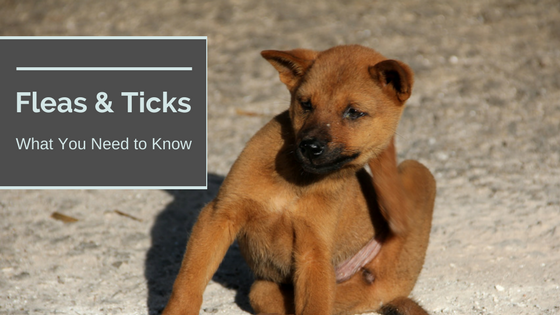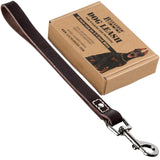It’s spring, and all dog owners know what that means – fleas and ticks are coming out in full force. The effects of fleas and ticks range from mere nuisance symptoms, to symptoms that are potentially deadly for your dog. But if fleas and ticks are everywhere, how can you prevent your dog from being bitten? And what do you do if they are bitten?
Prevention

As always, the first step is to talk to your vet. She’ll be able to get you started on a flea and tick prevention regimen that’s best for your dog. Those medications come in several different forms – oral, nasal sprays, and spot treatment – and you can work together to decide which one is best for your pet. These medications, though administered differently, all work similarly. They all have chemicals to kill adult fleas and ticks, and some of them have additional ingredients to kill off any flea and tick larvae as well. Which one you decide to go with is mainly a choice about which is easier to administer to your dog.
Make sure your vet is screening for tick-borne illness at your dog’s annual screening as well. The test doesn’t take long, and results are available almost immediately. You shouldn’t wait for this exam, of course, if you suspect your dog has been bitten by a tick, but it should still be part of your dog’s primary care.
Caring for Flea Bites
But what if your dog is bitten anyway? Flea bites are mainly a nuisance; they rarely cause any permanent damage. If your dog is bitten by a flea, you’ll see a lot of scratching, (seriously, so much scratching), red, flaky skin, hotspots, possibly some hair loss. If this happens, you can go to the vet to get some creams, but if it’s after hours or the weekend, you can start treating it yourself. Get a dog-specific anti-flea shampoo (you should be able to get this at your local pet store or even grocery store) and bathe your dog right away. Don’t use human shampoo, because they’re formulated for human pH levels, not your dog’s. This will get rid of most of the fleas that are currently on your dog, so do this first.
You can, however, give your dog the human version of allergy medications, like Benadryl or other antihistamine. Be sure to check the dosage information so you give him the right amount, though. This should help with any itchiness or pain. You can also use an over-the-counter antiseptic or antibiotic cream to lower the chances of infection.
Once you’ve taken care of the immediate itching and scratching on your dog, you’ll need to keep up with the treatment. Follow the instructions on the shampoo bottle for how often to bathe your dog during the current infestation. You’ll also have to clean your home. You’re going to have to clean your home better than you’ve ever cleaned it before, because fleas are tiny, and their eggs are even tinier. You might notice the adult fleas hopping around, but you won’t find the eggs with the naked eye. So you’re going to have to wash anything that fits into your washer, including cushion covers, bedding, clothing, dog toys, area rugs, floor mats, all of it. And vacuum. So much vacuuming. You should repeat this more than once, washing everything in hot water to be sure you’re killing all of the eggs.
Caring for Tick Bites
Ticks are much more dangerous. The results of a tick bite can be catastrophic for your dog, so it’s very important to remove the tick immediately upon discovery. Tick bites can lead to infection, abscesses, paralysis, even death if they’re not caught and treated immediately. If you live in an area that’s infested with ticks, you should check your dog after every outing, once a day at minimum. Run your hands over your dog’s body, checking for a bump or an area that feels swollen. If you find a bump, look to see if a tick has burrowed in there. Ticks are generally dark in color and the bumps can range from the size of a pinhead to the size of a grape. Depending on how where the tick is and how big it is, you might even be able to see its legs. If you do find a tick, use tweezers to grab the tick by its head and remove it. It’s important to be sure you remove the head and every last bit of the tick to prevent an infection in your dog. If you’re concerned about this, you can take your dog to a nearby vet and ask them to do it for you. And it sounds gross, but you want to keep the tick. Put it in a jar with isopropyl alcohol and note the date. If your dog begins displaying symptoms of any tick-borne illness, your vet will need this information.
What symptoms should you watch out for? Well, that depends on the specific tick-borne illness your dog has. Ticks can give your dog Lyme Disease, Rocky Mountain Spotted Fever, Anaplamosis, and Ehrlichiosis just to name a few of the potential illnesses. Some of the common symptoms for these diseases include fever, swollen lymph nodes, lack of appetite, and lethargy. If you see any of these symptoms, call your vet immediately. But some of the diseases have
Treatment for any of these tick-borne illnesses can be long, and will be expensive, so the best way to deal with fleas and ticks is to prevent your dog from being bitten in the first place. And follow your vet’s directions while your dog recovers. Dogs are excellent at hiding their pain, and they’ll be eager to get back to their usual routine. That doesn’t mean they’re ready though; their bodies are going through a lot and they need ample time to recover. Follow up with your vet at the suggested intervals and give your dog every dose of medicine the vet prescribes.
With a little preparation, you and your dog will get through flea and tick season bite-free. (Your dog will, anyway. You’re on your own).













